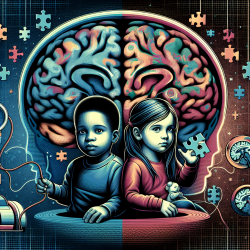Introduction
Autism Spectrum Disorder (ASD) is a complex neurodevelopmental condition often accompanied by language impairments. Understanding the neural underpinnings of these impairments is crucial for developing effective interventions. Recent research, as highlighted in the study "Structural brain abnormalities and their association with language impairment in school-aged children with Autism Spectrum Disorder," provides valuable insights into the structural brain differences in children with ASD and their relation to language abilities.
Key Findings from the Research
The study utilized structural magnetic resonance imaging (MRI) to compare brain structures between children with ASD and typically developing (TD) children. The research focused on both volume-based and surface-based characteristics of the brain, revealing significant differences in gray matter (GM) thickness and gyrification in language-related areas.
- Children with ASD exhibited reduced GM volume and thickness in several brain regions compared to TD children.
- Increased gyrification in certain areas was associated with more severe language impairments in children with ASD.
- GM thickness and gyrification were more strongly related to language functioning than other parameters like white matter volume or sulcus depth.
Implications for Practitioners
These findings underscore the importance of focusing on structural brain characteristics when assessing and planning interventions for children with ASD. Practitioners can enhance their approaches by considering the following strategies:
- Incorporate Neuroimaging: Utilizing MRI data can provide a clearer picture of the structural differences in a child's brain, allowing for more tailored intervention strategies.
- Focus on Language-Related Areas: Emphasizing therapies that target language-related brain regions may yield better outcomes for children with ASD.
- Monitor Structural Changes: Regular assessments can help track changes in brain structure over time, aiding in the adjustment of therapeutic approaches as needed.
Encouraging Further Research
The study highlights the need for further research to explore the development of these structural abnormalities over time and their direct impact on language abilities. Practitioners are encouraged to engage in or support research efforts that aim to:
- Examine longitudinal changes in brain structure and their correlation with language development in children with ASD.
- Investigate the efficacy of different intervention strategies on altering brain structure and improving language outcomes.
- Explore the specificity of these structural abnormalities to ASD compared to other neurodevelopmental disorders.
By integrating these insights into practice and research, practitioners can contribute to a more nuanced understanding of ASD and the development of more effective interventions.
To read the original research paper, please follow this link: Structural brain abnormalities and their association with language impairment in school-aged children with Autism Spectrum Disorder.










